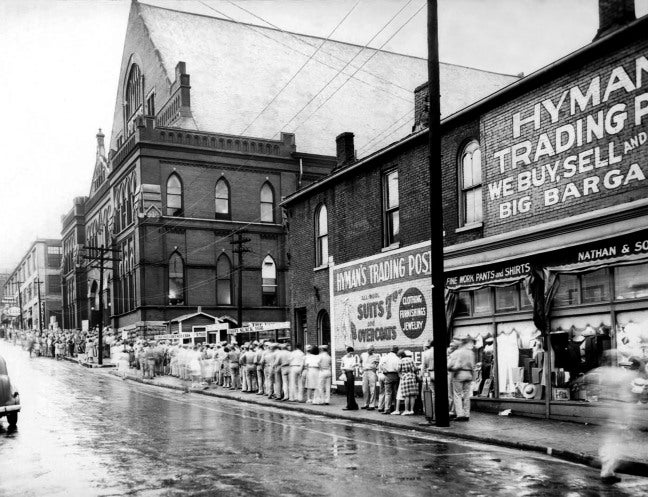Evolution of the Ryman: A Revivalist’s Spirit
Over the course of 130 years, Ryman Auditorium has transformed from a religious entity to one of the most revered music venues in the world. This is where it all began.
Divine Intervention
The Ryman has always been where dreamers, rebels, and trailblazers belong.
It started with Thomas Ryman, a wealthy and crude riverboat captain who spent his time gambling in downtown Nashville. One afternoon in 1885, thousands gathered at Eighth Ave and Broad Street. Ryman, who wasn’t a religious man by any means, wanted to know what all the fuss was about. He walked into a tent revival where Reverend Sam Jones, a charismatic and well-known evangelist, remarkably convinced Ryman to turn his life over to God with one sermon.
Ryman began dreaming of a grand tabernacle for religious gatherings in the city. Seven years later, with the help and donations of the surrounding community, the Union Gospel Tabernacle opened, three blocks from where Thomas Ryman was converted.
“I believe for every dollar spent in this Tabernacle, there’ll be $10 less spent in the future on court trials,” Jones declared from behind the pulpit in 1892. “This tabernacle is the best investment the city of Nashville ever made.”
A Stage Open For All
The Ryman’s first concert, the May Music Festival with the Theodore Thomas Orchestra, ran from May 4 to May 7, 1892. It was a musical success and a financial failure. Still, the tabernacle became a hot spot for educational events, religious gatherings, and entertainment.
The Southern Baptist Convention met there. Booker T. Washington gave a lecture from the stage. In 1892, the African-American acapella ensemble The Fisk Jubilee Singers performed at the Ryman – and they continue to perform at the Mother Church to this day. What was built as a religious sanctuary for Nashvillians, quickly became bigger than Ryman, Jones, or the local revivalists.
It became the Soul of Nashville.
The space was too small from the start. In February of 1897, Jones said he, “would never hold another revival in Nashville until the gallery (balcony) is built.” He was, “tired of being crowded to death.”
At the end of the Confederate Veterans' seventh reunion, the group donated $2,724 to the Ryman’s building fund as a thank you for the event space. As a result, the gallery was labeled the “Confederate Gallery,” on a wooden plaque at the front of the balcony. In 2017, the plaque was removed. Now, a new one reads, “1892 Ryman Auditorium," honoring its 130-year legacy.
Captain Ryman died on Dec. 23, 1904. He was regarded by thousands of mourners as a kind and generous man of faith, and an exceptional businessman. At his funeral on Christmas Day, Rev. Jones took a vote to rename the tabernacle in his honor. The audience responded with a standing ovation and the Union Gospel Tabernacle officially became Ryman Auditorium.

The Reign of Lula
Dozens of soon-to-be historical figures like Susan B. Anthony, Helen Keller, Charlie Chaplin, and Harry Houdini appeared at the Ryman during this time. Tennessee legend Jack Daniel attended a lecture by former President Theodore Roosevelt at the Ryman in 1907. A few years later, former President William Howard Taft delivered an address from the same stage.
A diverse and sometimes controversial lineup of famed artists, politicians, performers, and personalities came through the tabernacle doors. The auditorium hosted graduations, boxing matches, ballets, operas, and a slew of other events and musical performances from various genres. The auditorium was open for any act that Ryman Manager Lula Naff thought would sell tickets.
The Ryman began to take shape as music’s most iconic stage under her reign. She was headstrong as a rare female presence in the male-dominated entertainment industry, and sometimes “rubbed people the wrong way,” according to Ryman Museum Curator Joshua Bronnenberg.
“She was known for being difficult,” he said. “The Ryman was her whole world. She worked long hours, didn’t take vacations, and didn’t spend money needlessly. She would go above and beyond to ensure things went as well as possible.”
Naff went to court for the right to show the provocative play “Tobacco Road,” and won. She is rumored to have refinanced her home to bring John McCormack, the “World’s Greatest Lyric Opera Tenor,” to the Ryman, and it paid off.
Naff was also responsible for bringing the Grand Ole Opry to Ryman Auditorium in 1943. After the show that made country music famous outgrew its four previous venues, it settled into the Ryman for nearly 31 years. For 11 years, the Ryman’s name was even changed to the “Grand Ole Opry House.”
In 1945, Earl Scruggs made his debut with Bill Monroe’s Blue Grass Boys, building the prototype for the bluegrass sound and immortalizing the Ryman as the birthplace of bluegrass music.
In 1955, Naff retired. But she kept a watchful eye over her beloved auditorium.

A Bittersweet Farewell
While the Grand Ole Opry resided at the Ryman, other events continued to take place. They built an ice rink on the stage in 1944 for the Hollywood Ice Revels. Louis Armstrong and his All Stars performed in 1957. Jackie Robinson spoke in 1962.
In 1969, the Grand Ole Opry announced it would be moving to a new theater that could accommodate the show’s growing audience and was far from the debauchery of downtown Nashville at the time. The Grand Ole Opry had its final show at the Ryman on March 15, 1974. Afterward, several artists including Johnny and June Carter Cash appeared on the show Grand Ole Gospel Time and sang “Will The Circle Be Unbroken” to end the final broadcast from the Ryman.
The Nashville landmark and cultural icon went on to sit largely empty and rumors of demolition spread throughout the area. Conversations about saving the structure by local historians and activists made their way to congress and a multi-year battle commenced over the fate of the Ryman.
The tabernacle doors were closed in 1974, but the spirit remained. Luckily, there was more in store for Nashville’s Mother Church.
Learn more Ryman history and see everything we're doing this year for the Ryman's 130th anniversary here.
Stay in Touch
What’s almost as iconic as visiting the Ryman? Always having the inside scoop!
Sign up for exclusive updates, offers, and events, so you never miss out on what’s happening at the Mother Church.





